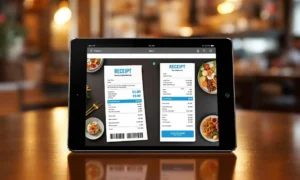Long waits, split ticketing, lost orders, and inaccurate stock counts make daily operations more difficult than they need to be. For medium and large outlets like restaurants, QSRs, cafes, and supermarkets, the challenge is real—multiple ordering channels create data silos and slow down staff. This prevents staff from focusing on service and makes forecasting harder for managers.
This guest post explains how a food ordering management system integrates online, kiosk, and in-venue orders into a single workflow, allowing operations to run smoothly and staff to regain time. It also highlights how a thoughtful restaurant database design integrates the system for real-time inventory and reporting.
Why Centralize Orders?
Start with the problem. Having separate streams for pickup apps, kiosks, and counter sales creates duplicate work and fragments order data. Centralization reduces duplicate entries, improves order accuracy, and enhances kitchen response times. When all channels feed into one system, menu updates, price changes, and promotions propagate instantly, rather than being updated in multiple places. This reduces inventory mismatches and helps staff stay focused on service.
Understanding these gains helps decide what to include in the integrated system.
Core Architecture Overview
Understand the components that make a central system function. A practical architecture consists of three layers: channel adapters, a central order engine, and operational apps. Channel adapters receive orders from marketplaces, mobile apps, kiosks, and in-venue terminals and convert them into a standard format. The central order engine manages routing, prioritization, and retries, while also updating inventory and sending orders to the kitchen display system (KDS) or the fulfillment queue.
Operational apps manager dashboards, reporting, and staff terminals all use the same normalized data, so each team sees the same status. For stable performance, the design requires robust message queuing, retry logic, and a well-indexed order store, often implemented as part of a scalable relational or hybrid database.
Next, see how data design supports reliable order flow.
Data Model and Database Notes
A solid data model prevents downstream errors. At the center is a clean order schema that links customer, order header, order items, modifiers, fulfillment channel, and timestamps. Catalog data (menu items, modifiers, and pricing) is stored in a versioned table, ensuring that active orders remain consistent even if menus change.
Inventory records are updated in real-time with each confirmed order to prevent overselling. For multi-site operations, tenant-aware tables and sharding help maintain speed and efficiency.
With structure in place, integrations glue channels together.
Integrations: Online Marketplaces, Kiosks, POS, and KDS
Integrations turn separate sales channels into one flow. Integrate delivery marketplaces via stable API adapters with idempotent handling to prevent duplicate orders. Kiosks should submit orders to the same engine as mobile apps, ensuring unified fulfillment priorities.
The POS must both accept direct in-venue payments and reflect orders routed from external channels. A KDS or preparation queue should display estimated prep time and channel flags, allowing staff to prioritize urgent or late orders.
The following section lists features required from a vendor.
Must-Have Features for Medium and Large Operators
Look for features that scale with volume and complexity:
- Centralized dashboard with filters by outlet, channel, and time window.
- Real-time inventory sync and stock alerts to avoid menu outages.
- Priority rules engine to schedule orders by prep time, delivery SLA, or VIP status.
- Kiosk support with offline mode and QR check-in for contactless queues.
- Order batching for delivery drivers and consolidation rules for pickup windows.
- APIs and webhooks for partner integrations and BI exports.
- Role-based access, audit logs, and PCI-compliant payments.
- Analytics with day-parting, item-level margins, and labor cost overlays.
These capabilities match what modern suites provide and reflect features Hashmato promotes for smart queue and order handling.
Below is a practical rollout path to reduce risk.
Practical Rollout Plan
A staged rollout reduces interruptions.
- Pilot in a single high-volume outlet to validate order normalization and KDS flow.
- Add kiosks and mobile channel in pilot locations while monitoring order accuracy.
- Turn on marketplace integrations one at a time and watch for duplicates or pricing drift.
- Gradually expand to additional locations in batches, using blue/green deployment for database schema changes.
- Train staff on new queue signals and exception handling; maintain a temporary dual view to compare the old and new systems until you are confident.
Track order accuracy, ticket times, and customer wait perception during each stage. Additionally, coordinate with the vendor to develop data migration and rollback plans.
Next, define how success will be measured.
KPIs and ROI Signals
Measure both customer experience and operational impact. Key metrics include average ticket time, order accuracy rate, on-time delivery percentage, average wait time for in-venue guests, and refunds/voids tied to order errors. Key financial KPIs to track include labor cost per order, food cost variance after centralization, and incremental revenue from reclaimed capacity (i.e., more covers per shift). Early wins typically manifest as fewer incorrect orders and reduced manual reconciliation time, which frees staff to focus on service tasks. Use reporting exports to feed BI tools for deeper trend analysis.
With KPIs defined, consider next the security and compliance aspects.
Security and Compliance Basics
Protect cardholder and customer data. Ensure PCI compliance for payment flows and secure APIs with OAuth or mutual TLS. Apply least-privilege access to dashboards and redact PII in long-term archives. For multi-state operations, confirm data residency requirements and tax rules for each jurisdiction. Regular penetration testing and encrypted backups keep the order store resilient.
These practices reduce risk while enabling the speed needed by medium and large food businesses.
Conclusion
A well-chosen food ordering management system becomes the operational backbone that unifies online marketplaces, kiosks, and on-site sales. For medium and large restaurant groups, QSRs, cafes, and supermarkets, centralization reduces errors, provides real-time inventory control, and unlocks analytics that support staffing and menu decisions. Begin with a focused pilot, verify order and inventory flows, and expand once baseline KPIs improve.
For practical guidance on designing the queue and order data model, consult the restaurant database design. If needed, a brief checklist can be provided to customize vendor evaluation for multi-site operations, including mandatory APIs, offline kiosk behavior, SLA targets for marketplaces, and sample data migration queries.





























